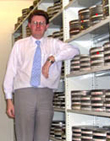|
|
 
|
|
Author
|
Topic: Old format archival and Digitization
|
|
|
|
|
Scott Norwood
Film God

Posts: 8146
From: Boston, MA. USA (1774.21 miles northeast of Dallas)
Registered: Jun 99
|
 posted 12-28-2003 08:18 PM
posted 12-28-2003 08:18 PM





Speed Graphic cameras use either 2x3" (rare) or 4x5" (common) film. It sounds like you have the 2x3" variety. With 4x5", any semi-pro photo lab would be able to make prints or scans (preferably high-end/expensive "drum scans") from the negs; I don't know about 2x3", which is an oddball and mostly obsolete format.
Super 8 Sound still exists, but is super expensive. Try Broadsky and Treadway (I have their contact info somewhere, but not handy...if no one else has it, bug me and I'll dig it up). They have (had?) a film chain setup for super 8 and 16mm that produces excellent results and they're cheaper than S8S.
Whatever you do, _always_ save the original material, as it will likely outlast the digitized version (digital != archival). Kodachrome should hold its color indefinitely if stored in a dark container and B&W material should outlast all of us. If any of the motion picture film smells like vinegar, store it far away from "good" film, lest the good film become afflicted with the dreaded "vinegar syndrome" (in which the film base turns to acid and self-destructs).
| IP: Logged
|
|
Frank Angel
Film God

Posts: 5305
From: Brooklyn NY USA
Registered: Dec 1999
|
 posted 12-29-2003 10:41 AM
posted 12-29-2003 10:41 AM





Scott, do you know if that lab can do 8mm work as opposed to S8mm? If Mike's Kodachrome prints are 50 years old, they wouldn't be Super 8.
I too have a box full of about 100 50ft reels of family 8mm Kodachrome from about 1940 thru the late 60s that still have near-IBTech color saturation and stability -- if only Eastman Kodak had adapted THAT process to make 35mm release prints, we'd all be very happy pups now!
I've been promising myself that I would transfer all that material myself, but have come to the conclusion that realistically that probably won't happen unless I retire (or get cloned). If there were a place that could make quality transfers, I would be willing to let them do it.
Even if someone else does the transfer, I will still have to edit it, which will be a monumental task and would still take a miracle to find the time.
I was going to nudge you get that contact info, but a little google work resulted in their site, which is: www.LittleFilm.com
And Mark, to answer my own question, yes they do transfer regular or "standard" 8mm reversal prints, which is what we both have. And BTW, the search also turned up a bunch of sites that have people testifying very positivily about the quality of the work that Broadsky and Treadway do; very good news.
| IP: Logged
|
|
|
|
Leo Enticknap
Film God

Posts: 7474
From: Loma Linda, CA
Registered: Jul 2000
|
 posted 01-01-2004 03:16 PM
posted 01-01-2004 03:16 PM





Agreed entirely with Scott - some of the small gauge transfers which Toni Treadway has done look astonishing. It's really a question of how much money you have to spend. There are facilities houses out there which have 8 and S8 heads for Spirits and Cintels - but you pay TV industry prices for that sort of job. At the other end of the scale are some of the people who advertise 'your home movies transferred to video' in the local rag, usually using a projector and camcorder rig. These can work surprisingly well, especially if thought has been given to synchronising the projector shutter and camcorder CCD scanning, but on the other hand they can be gruesome. Unless you know someone by reputation, it's probably a case of pot luck.
quote:
The condition of the motion picture film is excellent upon my inspection. The only problem i saw is that the film tends to bend because its been on the reel for 40 years.
All acetate base stock will shrink a little bit and become brittle when stored over a long time period, especially at room temperature. Regardless of how you proceed with a telecine transfer, I'd suggest storing the original elements in as cool and as dry a place as you can. Low temperature and humidity inhibits base decomposition, and another piece of good news is that post-1938 Kodachrome is pretty much bulletproof against colour dye fading. If you want to read chapter and verse on this, see Henry Wilhelm & Carol Brower, The Preservation and Care of Color Negatives, Slides & Motion Pictures, Grinnell, Iowa (1991).
| IP: Logged
|
|
|
|
All times are Central (GMT -6:00)
|
|
Powered by Infopop Corporation
UBB.classicTM
6.3.1.2
The Film-Tech Forums are designed for various members related to the cinema industry to express their opinions, viewpoints and testimonials on various products, services and events based upon speculation, personal knowledge and factual information through use, therefore all views represented here allow no liability upon the publishers of this web site and the owners of said views assume no liability for any ill will resulting from these postings. The posts made here are for educational as well as entertainment purposes and as such anyone viewing this portion of the website must accept these views as statements of the author of that opinion
and agrees to release the authors from any and all liability.
|

 Home
Home
 Products
Products
 Store
Store
 Forum
Forum
 Warehouse
Warehouse
 Contact Us
Contact Us




 Printer-friendly view of this topic
Printer-friendly view of this topic














